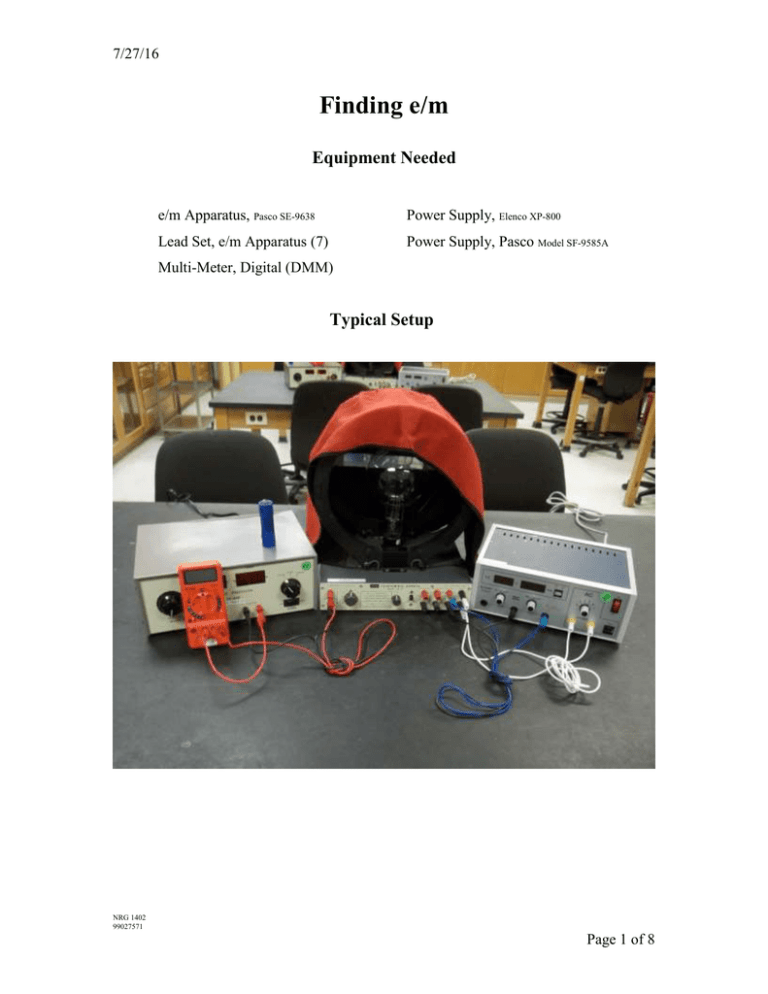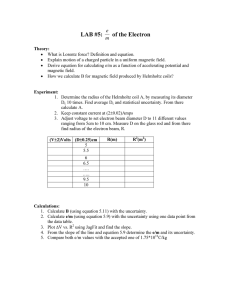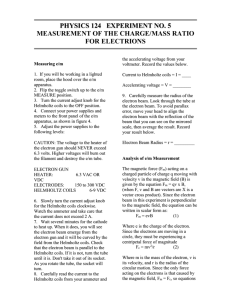Finding e/m Equipment Needed
advertisement

7/27/16 Finding e/m Equipment Needed e/m Apparatus, Pasco SE-9638 Power Supply, Elenco XP-800 Lead Set, e/m Apparatus (7) Power Supply, Pasco Model SF-9585A Multi-Meter, Digital (DMM) Typical Setup NRG 1402 99027571 Page 1 of 8 7/27/16 Introduction The PASCO Model SE-9638 e/m Apparatus provides a simple method for measuring e/m, the charge to mass ration of the electron. The method is similar to that used by J. J. Thompson in 1897. A beam of electrons is accelerated through a known potential, so the velocity of the electrons is known. A pair of Helmholtz coils produces a Figure 1 uniform and measurable magnetic field at right angles to the electron beam. This magnetic field deflects the electron beam in a circular path. By measuring the accelerating potential (V), the current to the Helmholtz coils (I), and the radius of the circular path of the electron beam (r), e/m is easily calculated: e 2V 2 2 . m B r (The calculations are explained in the operation section of this manual.) The e/m apparatus also has deflection plates that can be used to demonstrate the effect of an electric field on the electron beam. This can be used as a confirmation of the negative charge of the electron, and also to demonstrate how an oscilloscope works. A unique feature of the e/m tube is that the socket rotates, allowing the electron beam to be oriented at any angle (from 0-90 degrees) with respect to the magnetic field from the Helmholtz coils. You can therefore rotate the tube and examine the vector nature of the magnetic forces on moving charged particles. Other experiments are also possible with the e/m tube. For example, you can use a small permanent magnet instead of the Helmholtz coils to investigate the effect of a magnetic field on the electron beam. NRG 1402 99027571 Page 2 of 8 7/27/16 Equipment Description The e/m Tube—The e/m tube (see Figure Figure 2 - 2) is filled with helium at a pressure of 10 2 mm Hg, and contains an electron gun and deflection plates. The electron beam leaves a visible trail in the tube, because some of the electrons collide with helium atoms, which are excited and then radiate visible light. The electron gun is shown in Figure 3. The heater heats the cathode, which emits electrons. The electrons are accelerated Figure 3 by a potential applied between the cathode and the anode. The grid is held positive with respect to the cathode and negative with respect to the anode. It helps focus the electron beam. Caution: The voltage to the heater of the electron gun should NEVER exceed 6.3 volts. Higher voltages will burn out the filament and destroy the e/m tube. The Helmholtz Coils—The geometry of Helmholtz coils—the radius of the coils is equal to their separation—provides a highly uniform magnetic field. The Helmholtz coils of the e/m apparatus have a radius and separation of 15 cm. Each coil has 130 turns. The magnetic field (B) produced by the coils is proportional to the current through the coils (I) times 7.80 x 10-4 tesla/ampere Btesla 7.80 10 I . 4 NRG 1402 99027571 Page 3 of 8 7/27/16 The Controls—The control panel of the e/m apparatus is straightforward. All connections are labeled. The hook-ups and operation are explained in the next section. Cloth Hood—The hood can be placed over the top of the e/m apparatus so the experiment can be performed in a lighted room. Mirrored Scale—A mirrored scale is attached to the back of the rear Helmholtz coil. It is illuminated by lights that light automatically when the heater of the electron gun is powered. By lining the electron beam up with its image in the mirrored scale, you can measure the radius of the beam path without parallax error. Procedure Measuring e/m 1. If you will be working in a lighted room, place the hood over the e/m apparatus. 2. Flip the toggle switch up to the e/m MEASURE position. 3. Turn the current adjust knob for the Helmholtz coils to the OFF position. 4. Connect your power supplies and meters to the front panel of the e/m apparatus, as shown in Figure 4 (below). (Full picture—last page. Figure 5) Figure 4 NRG 1402 99027571 Page 4 of 8 7/27/16 5. Adjust the power supplies to the following levels. The voltmeter in Figure is not necessary because the meters on the Pasco SF-9585A power supply are of the same quality. (Note: Make sure all settings are in the zero position before turning on the power switch.): Electron Gun Heater: Electrodes: HelmHoltz Coils: 6.3 VAC or VDC 150 to 300 VDC 6-9 VDC Caution: The voltage to the heater of the electron gun should NEVER exceed 6.3 volts. Higher voltages will burn out the filament and destroy the e/m tube. 6. Wait several minutes for the cathode to heat up. When it does, you will see the electron beam emerge from the electron gun. 7. Slowly turn the current adjust knob for the Helmholtz coils clockwise. Watch the ammeter and take care that the current does not exceed 2 A. The field from the Helmholtz coils will curve the electron beam. (Check that the electron beam is parallel to the Helmholtz coils. If it is not, allow your instructor or lab tech to adjust it.) 8. Carefully read the current to the Helmholtz coils from your ammeter and the accelerating voltage from the voltmeter on the Pasco power supply. Record the values below. a. Current to Helmholtz coils = I = _________________________ b. Accelerating voltage = V = _____________________________ 9. Carefully measure the radius of the electron beam. Look through the tube at the electron beam. To avoid parallax errors, move your head (up-down and side-side) to align the electron beam with the reflection of the beam that you can on the mirrored scale. Measure the radius of the beam as you see it on both sides of the scale, and then average the results. Record your result below. NRG 1402 99027571 Page 5 of 8 7/27/16 Note 1: For ‘line up’ of each beam. Move the head left to right and up and down. Note 2: By using the current adjust; try to make the line of sight on the beam cross the scale in a perpendicular manner. a. Electron beam radius = r = _____________________________ Analysis of e/m Measurement The magnetic force ( Fm ) acting on a charged particle of charge q moving with velocity v in a magnetic field (B) is given by the equation , (where F, v, and B are vectors and is a vector cross product.) Since the electron beam in this experiment is perpendicular to the magnetic field, the equation can be written in scalar form as: Fm evB Equation 1 where e is the charge of the electron. Since the electrons are moving in a circle, they must be experiencing a centripetal force of magnitude Fm mv 2 r Equation 2 where m is the mass of the electron, v is its velocity, and r is the radius of the circular motion. Since the only force acting on the electrons is that caused by the magnetic field, Fm Fc , so equations 1 and 2 can be combined to give evB mv 2 r or e v m Br Equation 3 NRG 1402 99027571 Page 6 of 8 7/27/16 Therefore, in order to determine e/m, it is only necessary to know the velocity of the electrons, the magnetic field produced by the Helmholtz coils, and the radius of the electron beam. The electrons are accelerated through the accelerating potential V, gaining kinetic energy equal to their charge time the accelerating potential. Therefore eV 1 2 mv . 2 The velocity of the electrons is therefore: 1 2eV 2 v m Equation 4 The magnetic field produced near the axis of a pair of Helmholtz coils is given by the equation: B N 0 I Equation 5 3 2 5 a 4 A derivation for this formula can be found in most introductory texts on electricity and magnetism. Equations 4 and 5 can be plugged into equation 3 to get a final formula for e/m: 3 5 2V a 2 e v 4 2 m Br N 0 Ir where: V the accelerating potential a the radius of the Helmholtz coils N the number of turns on each Helmholtz coil = 130 0 the permeability constant 4 10 7 I the current through the Helmholtz coils r the radius of the electron beam path NRG 1402 99027571 Page 7 of 8 7/27/16 Figure 5 CE Pasco Scientific SF-9585A V 50 V Adjust on AC mA 500 V Adjust off Reset 3A MAX DC +500 V -50V 0 Volts Amps Elenco Precision XP-800 0-40VAC 0-28VDC - Voltage Adjust Helmholtz Coils + Current Adj 28VDC + e/m Experimental Apparatus Voltmeter Deflect Plates Electrodes Heater Focus - Note: The digital ammeter is not shown is this diagram. It is shown, however, in Figure 4. The digital voltmeter shown in Figure 4 is not necessary due to the accuracy of the Pasco unit. NRG 1402 99027571 Page 8 of 8







